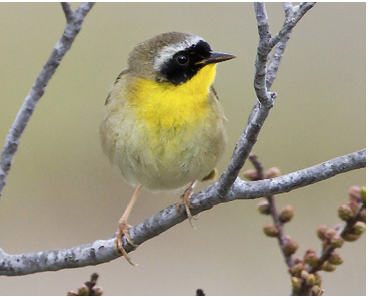Martha Steele

Common Yellowthroat. Photograph by Sandy Selesky.
Think of all the times that you bird a particular location, be it your own property or a favored birding haunt, and see, year after year, a species return to its breeding area. A Common Yellowthroat, for example, shows up annually in our Vermont yard, often singing in the early morning from a specific thicket, and has been doing so for well over a decade. It seems likely that some individuals returned for consecutive years. Still, it is also clear that many individuals occupied this territory in succession, somehow choosing to sing from the same thicket as their predecessors.
Plenty of other inviting and appropriate habitats for the Common Yellowthroat exist in our area, but our yard appears to be a favored place to set up shop and begin courting. I often wonder why here and not some place down the road or on other nearby properties. Several houses with similar habitats of thickets, fields, and forest edges exist within a few miles of us, but not all of them feature Common Yellowthroats. Whatever the reasons, I am so happy that we are privileged to host this bird year after year.
So many species seem to return to certain spots near our Vermont home: the Wood Thrush along our road, Wood Warbler Way; multiple Winter Wrens within earshot of the house; the Veery down by the mailbox; the Blue-headed Vireo in our sugar maple trees in the front yard; the Ruby-throated Hummingbirds flitting among the bee balm; and the Blackburnian Warbler at the tip of the red pines outside our bedroom window. Omnipresent every year are Ovenbirds, answering each other in a cascading chorus of song from all around us.
It will never cease to amaze me how these birds repeatedly find their way back to their breeding homes following their migratory journeys over thousands of miles. It is something I think about every time I hear a new arrival of an old friend in the spring, relieved that they made it and fervently wishing them well.
I also think about my connection to place and why a place may beckon me to return time and again. Unlike the birds, I do not return because the place offers abundant food, superb nesting habitat, and protection from predators. Instead, I connect to a place because of its beauty, its floral and animal inhabitants, and perhaps most of all the memories it conjures up. Thinking of our family seasonal home on Lake Champlain in Burlington, Vermont, where we have returned every summer since the 1950s, brings a flood of memories of carefree childhood days in the water, summer reading on the beach, capture-the-flag games with neighborhood kids, brilliant sunsets over the Adirondacks across the lake, baseball games on the radio, pajama evenings at the drive-in movie theater, wild card games of Pounce on the floor during rainy days, hikes up Camel’s Hump, August outings to pick wild blackberries, and so much more.
Likewise, for birders there is no shortage of meaningful places, to which we return over and over: Mount Auburn Cemetery in the spring, Mount Wachusett in the fall, Cape Ann in the winter, and Race Point in Provincetown after any storm. Each time we return, we seek to create new memories while old memories boil to the surface. Places carry so many memories and so many emotions. Every time Bob and I return to Marconi Beach in the Cape Cod National Seashore in Wellfleet, we point to the tree along the bike path where we saw Bohemian Waxwings more than 20 years ago when we first started our courtship. We return year after year to specific spots to find species difficult to find elsewhere, such as the Bicknell’s Thrush on the summit of Jay Peak in northeastern Vermont or Vesper, Grasshopper, and Field sparrows in the Pine Hill Road Grasslands area of central Massachusetts. We are intertwined, the birds and birders, one returning to suitable habitat and hardwired for breeding success, the other making annual pilgrimages to specific places to satiate a bottomless appetite for the presence of birds.
Our house in the Northeast Kingdom of Vermont has proven to be a magnet for birds, birders, and nonbirders alike. Beyond family, this place lures many friends visiting from five continents across the globe to return time and again. They have come in all seasons to hike, bird, bike, ski, swim, work alongside us, and visit over drinks and dinners often featuring produce from our gardens. Avian visitors, most recorded every year, now include 122 species on our property. 2020 has been a notable year, with Tufted Titmouse, Northern Cardinal, House Wren, Connecticut Warbler, and Willow Flycatcher all joining our property list for the first time ever.
Yes, we humans, like birds, are drawn back to our meaningful places time and again. For the birds, it is a practical return to a place that usually has meant successful breeding. For us, our return is far more esoteric. These places rejuvenate our spirits, continue long-standing traditions, or repeatedly provide experiences that bring joy or contentment. Sure, the places special and unique to each one of us represent memories of wonderful birds. But they may also invite contemplation of whatever we are facing in the moment and thus are places that many of us return to not just for the birds but for a beauty, serenity, and ambiance that encourage reflection.
Martha Steele, a former editor of Bird Observer, has been progressively losing vision due to retinitis pigmentosa and is legally blind. Thanks to a cochlear implant, she is now learning to identify birds from their songs and calls. Martha lives with her husband Bob Stymeist, in Arlington. Martha can be reached at marthajs@verizon.net.